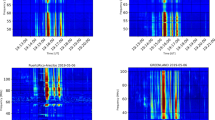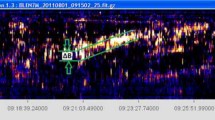Abstract
A new high-resolution radio spectropolarimeter instrument operating in the frequency range of 15 – 85 MHz has recently been commissioned at the Radio Astronomy Field Station of the Indian Institute of Astrophysics at Gauribidanur, 100 km north of Bangalore, India. We describe the design and construction of this instrument. We present observations of a solar radio noise storm associated with Active Region (AR) 12567 in the frequency range of \({\approx}\,15\,\mbox{--}\,85~\mbox{MHz}\) during 18 and 19 July 2016, observed using this instrument in the meridian-transit mode. This is the first report that we are aware of in which both the burst and continuum properties are derived simultaneously. Spectral indices and degree of polarization of both the continuum radiation and bursts are estimated. It is found that
-
i)
Type I storm bursts have a spectral index of \({\approx}\,{+}3.5\),
-
ii)
the spectral index of the background continuum is \({\approx}\,{+}2.9\),
-
iii)
the transition frequency between Type I and Type III storms occurs at \({\approx}\,55~\mbox{MHz}\),
-
iv)
Type III bursts have an average spectral index of \({\approx}\,{-}2.7\),
-
v)
the spectral index of the Type III continuum is \({\approx}\,{-}1.6\), and
-
vi)
the degree of circular polarization of all Type I (Type III) bursts is \({\approx}\,90\%\) (\(30\%\)).
The results obtained here indicate that the continuum emission is due to bursts occurring in rapid succession. We find that the derived parameters for Type I bursts are consistent with suprathermal electron acceleration theory and those of Type III favor fundamental plasma emission.

















Similar content being viewed by others
Notes
By transition region, we mean the region corresponding to the plasma frequency where the Type I bursts “transition” to Type III bursts.
See casper.berkeley.edu/ .
A FIFO buffer of variable size and read/write clocks.
References
Allen, C.W.: 1947, Solar radio-noise of 200 mc./s. and its relation to solar observations. Mon. Not. Roy. Astron. Soc. 107(4), 386. DOI . mnras.oxfordjournals.org/content/107/4/386.abstract .
Benkevitch, L.V., Rogers, A.E.E., Lonsdale, C.J., Cappallo, R.J., Oberoi, D., Erickson, P.J., Baker, K.A.V.: 2016, Van Vleck correction generalization for complex correlators with multilevel quantization. ADS .
Benz, A.O., Wentzel, D.G.: 1981, Coronal evolution and solar type i radio bursts – an ion-acoustic wave model. Astron. Astrophys. 94, 100. ADS .
Boischot, A., de La Noe, J., Moller-Pedersen, B.: 1970, Relation between metric and decametric noise storm activity. Astron. Astrophys. 4, 159. ADS .
Crochiere, R.E., Rabiner, L.R.: 1983, Multirate Digital Signal Processing, 4th edn., Prentice-Hall Signal Processing Series: Advanced Monographs 1, Prentice Hall, Upper Saddle River.
de La Noe, J., Gergely, T.E.: 1977, The spectrum and position of solar noise storms at decameter wavelengths. Solar Phys. 55, 195. DOI . ADS .
Dodson, H.W.: 1957, Relation between optical solar features and solar radio emission. In: van de Hulst, H.C. (ed.) Radio Astronomy, IAU Symposium 4, 327. ADS .
Dulk, G.A., Suzuki, S.: 1980, The position and polarization of Type III solar bursts. Astron. Astrophys. 88, 203. ADS .
Ebenezer, E., Ramesh, R., Subramanian, K.R., Sundara Rajan, M.S., Sastry, C.V.: 2001, A new digital spectrograph for observations of radio burst emission from the Sun. Astron. Astrophys. 367, 1112. ADS .
Elgarøy, E.Ø.: 1977, Solar noise storms. ADS .
Ellingson, S.W., Clarke, T.E., Cohen, A., Craig, J., Kassim, N.E., Pihlstrom, Y., Rickard, L.J., Taylor, G.B.: 2009, The long wavelength array. Proc. IEEE 97(8), 1421.
Gergely, T.E., Erickson, W.C.: 1975, Decameter storm radiation. I. Solar Phys. 42, 467. DOI . ADS .
Gergely, T.E., Kundu, M.R.: 1975, Decameter storm radiation. II. Solar Phys. 41, 163. DOI . ADS .
Hariharan, K., Ramesh, R., Kathiravan, C., Abhilash, H.N., Rajalingam, M.: 2016, High dynamic range observations of solar coronal transients at low radio frequencies with a spectro-correlator. Astrophys. J. Suppl. 222(2), 21. stacks.iop.org/0067-0049/222/i=2/a=21 .
Hey, J.S., Parsons, S.J., Phillips, J.W.: 1948, Some characteristics of solar radio emissions. Mon. Not. Roy. Astron. Soc. 108, 354. DOI . ADS .
Iwai, K., Tsuchiya, F., Morioka, A., Misawa, H.: 2012, IPRT/AMATERAS: a new metric spectrum observation system for solar radio bursts. Solar Phys. 277, 447. DOI . ADS .
Kathiravan, C., Ramesh, R., Nataraj, H.S.: 2007, The post-coronal mass ejection solar atmosphere and radio noise storm activity. Astrophys. J. Lett. 656, L37. DOI . ADS .
Kathiravan, C., Ramesh, R., Indrajit, V. Barve, Rajalingam, M.: 2011, Radio observations of the solar corona during an eclipse. Astrophys. J. 730, 91. ADS .
Kerdraon, A., Pick, M., Trottet, G., Sawyer, C., Illing, R., Wagner, W., House, L.: 1983, The association of radio noise storm enhancements with the appearance of additional material in the corona. Astrophys. J. Lett. 265, L19. ADS .
Kishore, P., Kathiravan, C., Ramesh, R., Rajalingam, M., Barve, I.V.: 2014, Gauribidanur low-frequency solar spectrograph. Solar Phys. 289(10), 3995. DOI .
McCready, L.L., Pawsey, J.L., Payne-Scott, R.: 1947, Solar radiation at radio frequencies and its relation to sunspots. Proc. Roy. Soc. London Ser. A, Math. Phys. Sci. 190, 357. DOI . ADS .
Melrose, D.B.: 1980, A plasma-emission mechanism for type i solar radio emission. Solar Phys. 67, 357. ADS .
Mercier, C., Trottet, G.: 1997, Coronal radio bursts: a signature of nanoflares? Astrophys. J. Lett. 474(1), L65. stacks.iop.org/1538-4357/474/i=1/a=L65 .
Mugundhan, V., Ramesh, R., Barve, I.V., Kathiravan, C., Gireesh, G.V.S., Kharb, P., Misra, A.: 2016, Low-frequency radio observations of the solar corona with arcminute angular resolution: implications for coronal turbulence and weak energy releases. Astrophys. J. 831, 154. DOI . ADS .
Nelson, G.J., Sheridan, K.V., Suzuki, S.: 1985, Measurements of solar flux density and polarization. In: McLean, D.J., Labrum, N.R. (eds.) Solar Radiophysics: Studies of Emission from the Sun at Metre Wavelengths, Cambridge University Press, Cambridge, 113. ADS .
Oberoi, D., Matthews, L.D., Cairns, I.H., Emrich, D., Lobzin, V., et al.: 2011, First spectroscopic imaging observations of the sun at low radio frequencies with the Murchison Widefield Array prototype. Astrophys. J. Lett. 728, L27. ADS .
Payne-Scott, R.: 1949, Bursts of solar radiation at metre wavelengths. Aust. J. Sci. Res., Ser. A 2, 214. ADS .
Price, D.C.: 2016, Spectrometers and polyphase filterbanks in radio astronomy. arXiv . ADS .
Pupillo, G., Naldi, G., Bianchi, G., Mattana, A., Monari, J., Perini, F., Poloni, M., Schiaffino, M., Bolli, P., Lingua, A., Aicardi, I., Bendea, H., Maschio, P., Piras, M., Virone, G., Paonessa, F., Farooqui, Z., Tibaldi, A., Addamo, G., Peverini, O.A., Tascone, R., Wijnholds, S.J.: 2015, Medicina array demonstrator: calibration and radiation pattern characterization using a UAV-mounted radio-frequency source. Exp. Astron. 39, 405. DOI . ADS .
Raja, K.S., Kathiravan, C., Ramesh, R., Rajalingam, M., Barve, I.V.: 2013, Design and performance of a low-frequency cross-polarized log-periodic dipole antenna. Astrophys. J. Suppl. 207(1), 2. stacks.iop.org/ 0067-0049/207/i=1/a=2 .
Ramesh, R., Kathiravan, I.C., Rajalingam, M.: 2012, High angular resolution radio observations of a coronal mass ejection source region at low frequencies during a solar eclipse. Astrophys. J. 744, 165. ADS .
Ramesh, R., Kathiravan, C., Narayanan, A.S.: 2011, Low-frequency observations of polarized emission from long-lived non-thermal radio sources in the solar corona. Astrophys. J. 734(1), 39. stacks.iop.org/0004- 637X/734/i=1/a=39 .
Ramesh, R., Shanmugha Sundaram, G.A.: 2001, Occurrence of metric noise storms and the onset of coronal mass ejections in the solar atmosphere. Solar Phys. 202, 355. ADS .
Ramesh, R., Subramanian, K.R., Sastry, C.V.: 1999, Eclipse observations of compact sources in the outer solar corona. Solar Phys. 185, 77. ADS .
Ramesh, R., Sundararajan, M.S., Sastry, C.V.: 2006, The 1024 channel digital correlator receiver of the Gauribidanur radioheliograph. Exp. Astron. 21, 31. DOI . ADS .
Ramesh, R., Subramanian, K.R., Sundararajan, M.S., Sastry, C.V.: 1998, The Gauribidanur Radioheliograph. Solar Phys. 181, 439. DOI . ADS .
Ramesh, R., Kathiravan, C., SundaraRajan, M.S., Barve, I.V., Sastry, C.V.: 2008, A low-frequency (\(30\,\mbox{--}\,110~\mbox{MHz}\)) antenna system for observations of polarized radio emission from the solar corona. Solar Phys. 253(1), 319. DOI .
Ramesh, R., Kathiravan, C., Barve, I.V., Beeharry, G.K., Rajasekara, G.N.: 2010, Radio observations of weak energy releases in the solar corona. Astrophys. J. Lett. 719, L41. ADS .
Ramesh, R., Sasikumar Raja, K., Kathiravan, C., Satya Narayanan, A.: 2013, Low-frequency radio observations of picoflare category energy releases in the solar atmosphere. Astrophys. J. 762, 89. ADS .
Ryle, M.: 1948, The generation of radio-frequency radiation in the sun. Proc. Roy. Soc. London Ser. A, Math. Phys. Sci. 195(1040), 82. www.jstor.org/stable/98304 .
Sasikumar Raja, K., Ramesh, R.: 2013, Low-frequency observations of transient quasi-periodic radio emission from the solar atmosphere. Astrophys. J. 775, 38. ADS .
Sault, R.J., Hamaker, J.P., Bregman, J.D.: 1996, Understanding radio polarimetry. II. Instrumental calibration of an interferometer array. Astron. Astrophys. Suppl. Ser. 117, 149. ADS .
Stewart, R.T., Labrum, N.R.: 1972, Meter-wavelength observations of the solar radio burst storm of August 17 – 22, 1968. Solar Phys. 27, 192. DOI . ADS .
Sundaram, G.A.S., Subramanian, K.R.: 2004, Spectrum of solar Type I continuum noise storm in the 50 – 80 MHz band and plasma characteristics in the associated source region. Astrophys. J. 605, 948. DOI . ADS .
Swarup, G., Stone, P.H., Maxwell, A.: 1960, The association of solar radio bursts with flares and prominences. Astrophys. J. 131, 725. DOI . ADS .
Thejappa, G.: 1991, A self-consistent model for the storm radio emission from the sun. Solar Phys. 132, 173. DOI . ADS .
Thompson, A.R., Moran, J.M., Swenson, G.W.: 2001, Interferometry and Synthesis in Radio Astronomy, 2nd edn., Wiley-VCH, Weinheim. cds.cern.ch/record/1320565 .
Tingay, S., Goeke, R., Bowman, J.D., Emrich, D., Ord, S., Mitchell, D.A., Morales, M.F., Booler, T., Crosse, B., Wayth, R., et al.: 2013, The Murchison Widefield Array: The Square Kilometre Array precursor at low radio frequencies. Publ. Astron. Soc. Austral. 30, e007.
Vaidyanathan, P.P.: 1993, Multirate Systems and Filter Banks, 1, Prentice Hall, Upper Saddle River. 0-13-605718-7.
van Haarlem, M., Wise, M., Gunst, A., Heald, G., McKean, J., Hessels, J., de Bruyn, A., Nijboer, R., Swinbank, J., Fallows, R., et al.: 2013, Lofar: the low-frequency array. Astron. Astrophys. 556, 2.
Wild, J.P.: 1951, Observations of the spectrum of high-intensity solar radiation at metre wavelengths. IV. Enhanced radiation. Aust. J. Sci. Res., Ser. A 4, 36. ADS .
Wild, J.P., McCready, L.L.: 1950, Observations of the spectrum of high-intensity solar radiation at metre wavelengths. I. The apparatus and spectral types of solar burst observed. Austral. J. Sci. Res., Ser. A 3, 387. ADS .
Zlobec, P.: 1971, Polarization of type I bursts. In: Abrami, A. (ed.) CESRA-2, Comm. European Solar Radio Astron. 2, 101. ADS .
Acknowledgements
It is a pleasure to thank the workshop staff in the Gauribidanur Observatory for assistance in the building of the array, and the observers there for effectively carrying out the observations reported in this work. We thank the referee for their comments that helped us to present the results in a better manner. V. Mugundhan would like to thank the CASPER consortium for providing open-source signal-processing libraries, M. Rajesh for providing the dual-frequency images with the GRAPH, K. Hariharan for fruitful discussions, and Anshu Kumari for thoroughly proofreading the manuscript. The portion of work carried out by A. Hegde was during her time as an Indian Academy of Sciences Summer Intern.
Author information
Authors and Affiliations
Corresponding author
Ethics declarations
Disclosure of Potential Conflicts of interest
We declare that there are no conflicts of interest for the work presented here.
Rights and permissions
About this article
Cite this article
Mugundhan, V., Ramesh, R., Kathiravan, C. et al. Spectropolarimetric Observations of Solar Noise Storms at Low Frequencies. Sol Phys 293, 41 (2018). https://doi.org/10.1007/s11207-018-1260-2
Received:
Accepted:
Published:
DOI: https://doi.org/10.1007/s11207-018-1260-2




